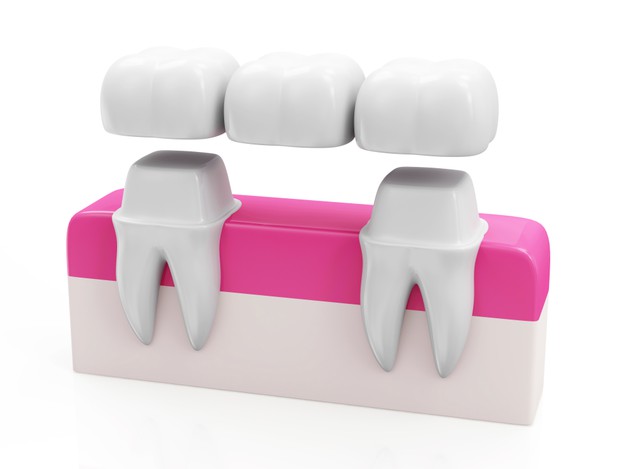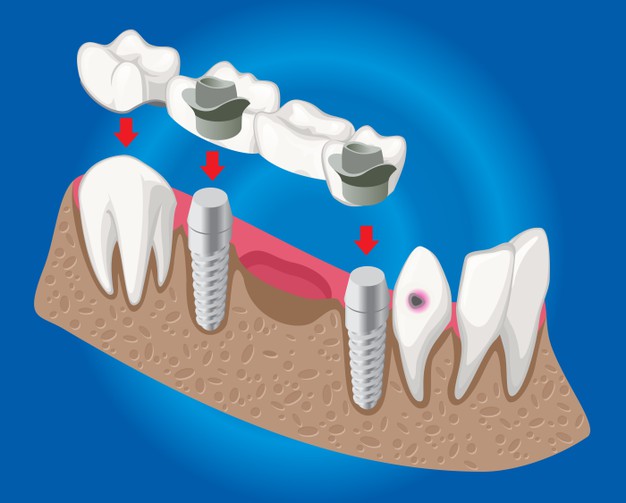"A smile is a curve that sets everything straight." ~ Phyllis Diller
Schedule an Appointment Today:
Dental Crowns & Bridges
Crowns and Bridges are an effective solution for damaged or missing teeth and are preferred by patients to partial dentures as they are a permanent solution and require far less ongoing maintenance besides that of general daily hygiene.

What's the Difference Between a Crown and a Bridge?
A bridge consists of two crowns which anchor and support a prosthetic tooth. A crown is a cap that can be placed over a damaged or decayed tooth. A crown is designed to maintain the original tooth's size, shape and appearance, whereas a bridge is specifically to replace a missing tooth.
Dental Crowns

A dental crown is created custom to each individual in order to maintain the integrity of the patient's bite as well as the appearance of their smile. A number of materials are available for dental crowns, each with their pros and cons varying in degrees of durability, strength, appearance and cost.
Types of Dental Crowns
Ceramic • Ceramic crowns are porcelain-based and are a popular material for dental crowns, due to their resemblance to natural teeth. These are a common choice for front teeth in order to maintain the appearance of your smile.
Base Metal Alloys • As these metals are highly resistant to corrosion, they form a longer lasting crown compared to ceramic options, however do not blend in color with your teeth.
Porcelain Fused to Metal • With the integrity of the base metal alloys together with the natural appearance of the porcelain exterior, these crowns are more durable than solely ceramic crowns.
Gold Alloys • Often a choice for those with bruxism, who tend to grind their teeth, these alloys made of gold, copper and other materials are sturdy as well as forgiving in terms of wear and tear on opposing teeth.
Crowns ultimately can be made from a variety of materials porcelain, metal, ceramic, zirconia, composite resin or a combination of the above.
How Long Do Crowns Last?
Crowns can last 15 years or longer with proper care. Proper oral hygiene practices improves the longevity of your crown. Habits such as chewing on pen caps, opening packaging, chewing ice, biting fingernails, grinding your teeth and other other harmful oral habits should be avoided the same as with a crown as they should be with your natural teeth.
How Do You Know When Dental Crowns Need to Be Replaced?
Cracks and chips are obvious signs that it's time for a replacement. Sometimes crowns just wear out over time. Other times cracks and chips can be caused by injury and accident, or by the poor dental habits listed above (chewing on ice, pencaps, grinding teeth, etc.)
Gum infection is another sign it may be time for a crown replacement. To avoid gum infections, especially with dental implants of any kind, it's important to have regular professional cleanings. It is recommended to get a cleaning every 6 months. If you do get an infection in the gums, however, it may be necessary to replace the crown at that time. Gum infections should always be handled swiftly to avoid damage to your jawbone and a major infection that could spread to other areas of your body.
Loose crowns can occur if the bonding weakens or falls off. A clicking noise when you speak or chew indicates a loose crown.
If any of these signs occur, it's essential to reach out for a replacement crown as quickly as possible, before the problem worsens.
Dental Bridges

A dental bridge is an appliance that is fixed between two porcelain crowns to fill a gap left by one or more missing teeth. A dental bridge is considered to be a permanent solution compared to partial dentures.
Types of Dental Bridges
Traditional Dental Bridge • Held in place by dental crowns, traditional bridges consist of one or more fake teeth (known as pontics). The crowns, or abutments are bonded to the teeth adjacent to the missing tooth or teeth.
In order to bond with the adjacent teeth, the enamel is worn down allowing the cement to fuse with the porous surface. For this reason, these teeth will need to remain protected by crowns, even if a different bridge is later chosen.
Maryland Bridges • A Maryland bridge is used to replace a missing tooth without first wearing down the enamel of the adjacent tooth in order to bond with the crown, such as is done with a traditional bridge.
This bridge uses a metal framework with a porcelain tooth in the center. Two metal wings are bonded to the back side of the teeth on either side of the gap. This method reduceds the damage to abutment teeth, leaving them bacially intact.
The drawbacks of the Maryland Bridge include it's limitations on space. It can only be used to fill a single gap. The metal framework will darken the appearance of the abutment teeth, and color matching of the prosthetic tooth is not likely with the metal base. It can last over 10 years but may need to be recemented every few years.
Cantilever Bridges • This form of bridge is not commonly used. It is designed for spaces where there is only one adjacent tooth to anchor to. However, they are not considered strong enough for back teeth.
Implant-Supported Bridges • An implant-supported bridge does not require any alteration to natural teeth. It is a superior method, medically speaking for its many benefits including preservation of the jaw and prevention of bone loss in many cases. However, it is a long term, multi-stage treatment as the mouth must heal for several months following the surgical placement of dental implants in the jaw. Once the initital implants have fused with the bone tissue, (osseointegration) the gums are opened up and the abutment posts for the bridge are attached directly to the implants before the dental bridge is finally attached to the abutment posts with a special compound.
How Long Do Bridges Last?
Like Dental Crowns, Dental Bridges last up to 15 years or longer if well cared for. Poor chewing/grinding habits or accidents can cause damage to your bridge and regular cleanings prevent other problems that may lead to premature dental bridge replacement.
How Do You Know When Dental Bridge Need to Be Replaced?
Because traditional bridges involved the wearing down of enamel on the abutment teeth, decay may be difficult to spot. If you experience sensitivity or any sign of gum infection, it's important to get into the dentist quickly to prevent a spreading infection.
It's essential to maintain a consistent hygiene schedule when you have any kind of dental implant, including cleanings every 6 months to prevent damage to the teeth beneath the crowns. But if this damage does occur, your bridge will likely have to be replaced, following treatment of the underlying problem.
If you notice any chips or cracks in your dental bridge, it's essential to get in for a repair. The longer you wait to act, the more likely the abutment teeth will begin to decay, cascading into further problems. A chipped porcelain coating can often be repaired, as can a fractured pontic (fake tooth) in many cases. But if the problem is with one of the abutment teeth, the bridge will have to be removed in order to address the issue.
Schedule an Appointment Today:
